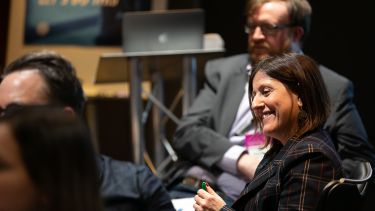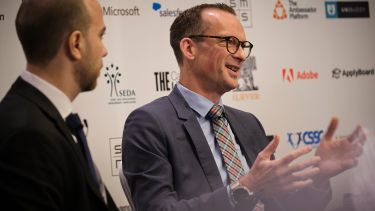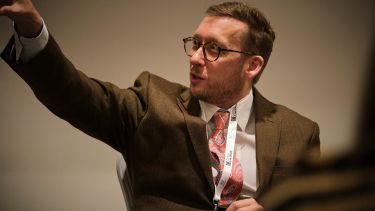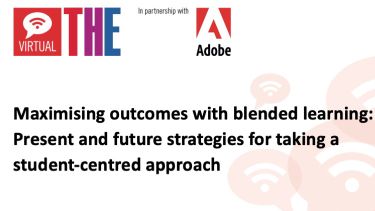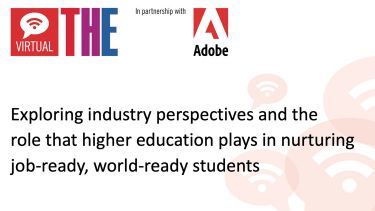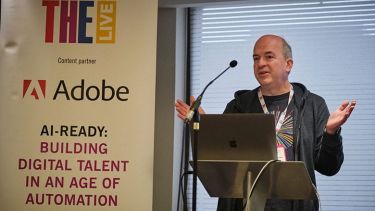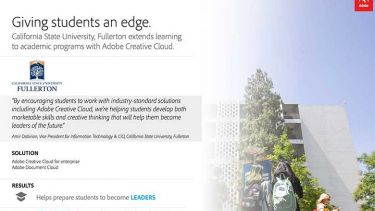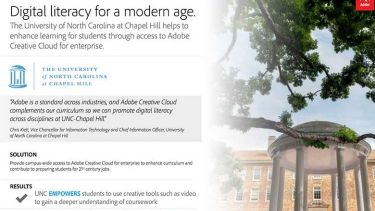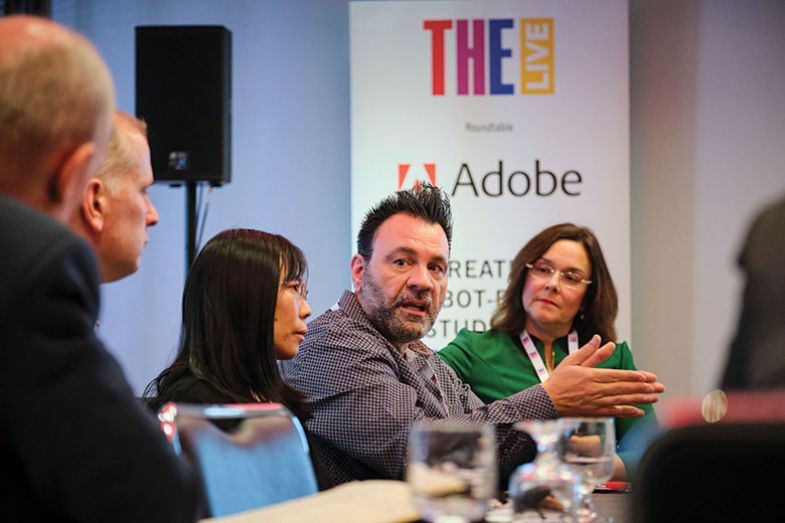
Source:
THE

An Adobe roundtable at THE Live discussed how innovation can help develop new pedagogies and agile learning programmes
The Fourth Industrial Revolution will disrupt higher education and ask profound questions about how universities should deliver their teaching. Some of these questions will require technological answers. Others will pose a philosophical challenge, as universities redefine what they stand for.
Today’s students know that they will soon embark on a career that will demand continuous personal development, as technology transforms how and what we work on. This infers an inbuilt knowledge obsolescence in the traditional model of a three- or four-year undergraduate programme.
Universities are in search of a model that delivers the skills required to support lifelong learning while also satisfying their academic mission. Innovation will be key, but what form should it take?
Mark Andrews is digital learning programme manager at Cambridge Judge Business School, University of Cambridge, and his experiences have led him to advocate a bottom-up innovation approach to future-proof his institution’s teaching.
Mr Andrews opened the Abobe roundtable event at THE Live 2019, which brought together a panel of higher education thought leaders, with a keynote address that highlighted some of the challenges he faced at Cambridge. Chief among them was finding the right approach to implement new ideas and fresh approaches to curriculum design in an environment that has been delivering higher education for more than 800 years. In the discussion that followed, there was a consensus that this challenge was not unique to his institution.
Mr Andrews framed his mission at Judge as one of closing the relevance gap – one that was particularly acute at business schools. “Business schools are blamed for the economic crash, for not producing graduates with the relevant skills for the industry they are going into,” he said. This has to change. Just as business schools are at the vanguard of disruption, they can be at the vanguard of the solution. There is a maverick quality to business schools, said Mr Andrews, and amid a climate of disruption, there lies opportunity. “We are seeing the rise of the lifelong learner and the real need to be providing lifelong learning,” he said. Judge had to be more student- and education-focused. “I saw this as our battle cry,” he added.
In practice, bottom-up innovation needed a “design thinking” approach. First, Judge had to empathise with students: what they wanted from their university education would drive the project. Such approaches can take practitioners out of their comfort zone. In Mr Andrews’ case, heading up learning design in a small team required him to be “part creative, part engineer”.
Bottom-up innovation helped harness the power of proximity. “What was key was that we were intrinsically motivated and invested in the project,” he said. “For any kind of innovation to succeed, it needs everybody to be totally on the same page.”
Once a programme goes live, it is then stress tested and amended on the fly. It constantly changes, explained Mr Andrews, but all the while, capabilities are locked in and can be applied in different learning contexts. Judge built strategic alliances, collaborating with Coursetune on pedagogies, with Adobe on digital literacy, and forming the SHAPE learning collective. Mr Andrews said he viewed Judge as the test pilot for innovation, and what worked there could then be rolled out or adapted for other disciplines.
Michael Capaldi, dean of innovation and business at Newcastle University, opened the roundtable discussion by recognising the need for all stakeholders – academics, professional staff and service staff – to share a common purpose and work together to drive innovation. “Certainly, that is something that hasn’t happened, either at Edinburgh or Newcastle, two of the universities I have experience of,” he said. “We are being forced to pull industry and business into some of those decision-making processes, in terms of pulling the right elements of the course together, and it is not something that has historically happened at most universities.”
Institutions needed to not only adapt to this new reality but also be cognisant of the changing expectations of the student body. Anastasia Konstantopoulou, associate dean (learning and teaching) at Edge Hill University, said students should be placed at the heart of any innovation, and that student feedback on curriculum changes could be remarkably insightful and valuable.
Adobe’s worldwide principle higher education development manager, Sebastian Distefano, agreed. Students needed to be empowered and the value of collaboration with the student body could not be overstated, he said. The educational space is becoming more open and students will seek out information elsewhere, for example by accessing lectures posted on YouTube by other universities, he noted. “That active learning experience is absolutely crucial to meeting students’ needs,” he added.
Amanda Broderick, vice-chancellor and president of the University of East London, said “creativity is the superpower of the Fourth Industrial Revolution” and that it was crucial for higher education institutions to immerse competencies throughout the learning process. “We have embedded principals of cognitive behavioural therapy within our core curriculum because this is not about producing oven-baked graduates,” she said. “This is about supporting individuals to develop the tools to succeed in their lives, and the tools that actually affect behaviours. That is possibly where, as a university sector, we have not provided enough reflection on.”
John Gill, roundtable chair and editor of Times Higher Education, asked if the UK was lagging behind the US in terms of graduates with the skills required of industry. Not necessarily, said Mr Distefano, who cited IBM’s in-house training programme as an example of how industry managed this shortfall.
“Is that a success or a failure of the education system, when a global company like that can’t find the graduates?” he asked. That might just be one of the questions higher education strategists are considering right now.
The panel
John Gill, editor, Times Higher Education (chair)
Stuart Allan, director of online learning, Edinburgh Business School, Heriot-Watt University
Amelia Au-Yeung, deputy dean (Claude Littner Business School), University of West London
Nick Braisby, vice-chancellor, Buckinghamshire New University
Amanda Broderick, vice-chancellor and president, University of East London
Michael Capaldi, dean of innovation and business, Newcastle University
Sebastian Distefano, worldwide principle higher education development manager, Adobe
Roger Emery, head of learning technologies, Solent University
Peter Francis, deputy vice-chancellor, Northumbria University
John Hill, head of digital learning, University of Derby
Janet Jones, dean of arts and creative industries, London South Bank University
Anatasia Konstantopoulou, associate dean (learning and teaching), Edge Hill University
Elodie Nowinski, dean of faculty of creative industries, City of Glasgow College
Norbert Pachler, pro-director, teaching, quality and learning innovation, University College London
Paul Ryan, pro vice-chancellor student experience, Regent’s University London
Leigh Sparks, deputy principal (education and students), University of Stirling
Find out more about Adobe’s solutions for higher education.
Join the THE Live mailing list here for all the latest THE Live news and exclusive offers.



